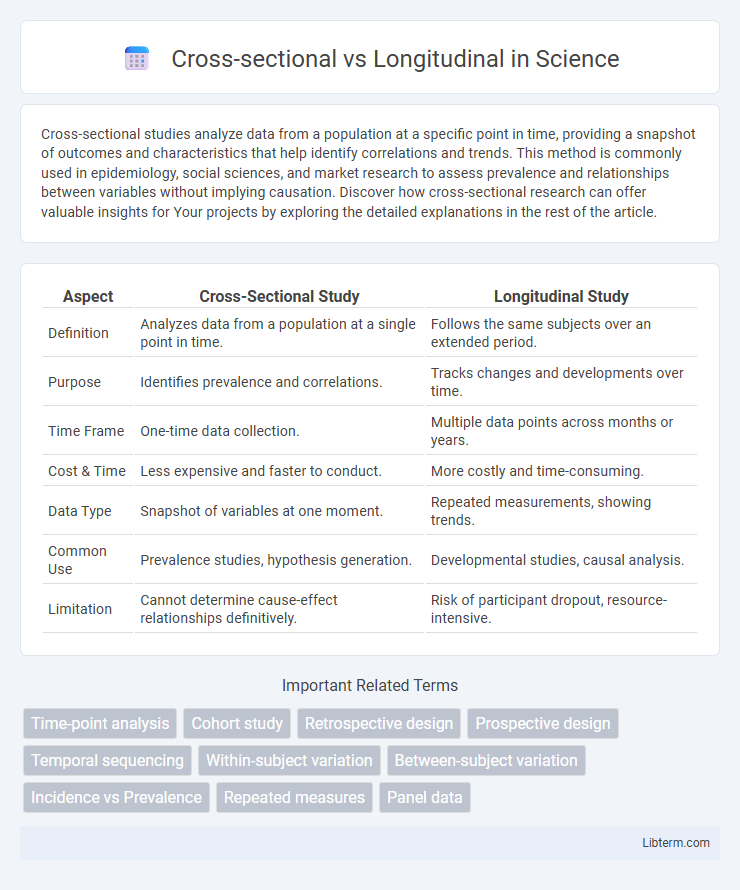Cross-sectional studies analyze data from a population at a specific point in time, providing a snapshot of outcomes and characteristics that help identify correlations and trends. This method is commonly used in epidemiology, social sciences, and market research to assess prevalence and relationships between variables without implying causation. Discover how cross-sectional research can offer valuable insights for Your projects by exploring the detailed explanations in the rest of the article.
Table of Comparison
| Aspect | Cross-Sectional Study | Longitudinal Study |
|---|---|---|
| Definition | Analyzes data from a population at a single point in time. | Follows the same subjects over an extended period. |
| Purpose | Identifies prevalence and correlations. | Tracks changes and developments over time. |
| Time Frame | One-time data collection. | Multiple data points across months or years. |
| Cost & Time | Less expensive and faster to conduct. | More costly and time-consuming. |
| Data Type | Snapshot of variables at one moment. | Repeated measurements, showing trends. |
| Common Use | Prevalence studies, hypothesis generation. | Developmental studies, causal analysis. |
| Limitation | Cannot determine cause-effect relationships definitively. | Risk of participant dropout, resource-intensive. |
Introduction to Study Designs
Cross-sectional studies capture data at a single point in time, providing a snapshot of variables and their relationships within a defined population. Longitudinal studies track the same subjects over an extended period, allowing researchers to observe changes and infer temporal patterns. Understanding these study designs is crucial for selecting appropriate methodologies in epidemiology, psychology, and social sciences to address specific research questions.
Defining Cross-Sectional Studies
Cross-sectional studies analyze data from a population or a representative subset at a single point in time, enabling researchers to assess prevalence and identify relationships among variables. These studies are commonly used in epidemiology and social sciences to provide a snapshot of current conditions or characteristics without tracking changes over time. By measuring multiple variables simultaneously, cross-sectional research efficiently evaluates associations, but it cannot establish causality or temporal sequences between factors.
Key Features of Longitudinal Studies
Longitudinal studies track the same subjects over extended periods to observe changes and developments, enabling precise analysis of cause-and-effect relationships. These studies provide valuable insights into growth patterns, behavioral changes, and long-term effects by collecting repeated measurements at multiple time points. Key features include temporal sequence data collection, high internal validity, and the ability to control for individual-level confounding variables.
Purpose and Scope of Each Method
Cross-sectional studies provide a snapshot of a population or phenomenon at a single point in time, allowing for comparisons across different groups or variables to identify patterns and correlations. Longitudinal studies track the same subjects over an extended period, enabling the analysis of changes, developments, and causal relationships within the data. The scope of cross-sectional research is broad but limited to temporal associations, while longitudinal research offers deep insights into temporal dynamics and causal inference.
Data Collection Techniques
Cross-sectional data collection captures information at a single point in time, allowing researchers to analyze variables across a wide population sample simultaneously. Longitudinal data collection involves repeated observations of the same variables over extended periods, enabling the study of changes and development within subjects. Survey questionnaires, interviews, and observational methods are common techniques for both, but longitudinal methods often require panel studies or cohort tracking to maintain consistent participant involvement.
Advantages of Cross-Sectional Studies
Cross-sectional studies provide a quick and cost-effective way to collect data from a large population at a single point in time, enabling researchers to identify prevalence and correlations efficiently. They eliminate the biases related to time-dependent factors and participant attrition common in longitudinal studies. This approach is particularly advantageous for public health assessments and epidemiological surveys where immediate snapshots of conditions or behaviors are required.
Benefits of Longitudinal Approaches
Longitudinal approaches provide the advantage of tracking changes and developments within the same subjects over time, offering deeper insights into causality and temporal sequences. This method captures dynamic processes, such as growth, aging, or behavioral shifts, that cross-sectional studies cannot reveal. Longitudinal data enhance the accuracy of predicting future outcomes and understanding individual variability in developmental patterns.
Limitations and Challenges
Cross-sectional studies face limitations such as the inability to establish causality and susceptibility to cohort effects, which can confound results due to differences in age groups or populations sampled at one point in time. Longitudinal studies present challenges including high costs, participant attrition over time, and difficulty maintaining consistent measurement methods across different waves. Both research designs require careful consideration of validity threats and resource allocation to accurately capture temporal or developmental changes.
When to Choose Cross-Sectional vs Longitudinal
Cross-sectional studies are optimal for analyzing data from a specific point in time, making them ideal for assessing prevalence or identifying associations quickly across diverse populations. Longitudinal studies are preferred when investigating changes and developments over time, such as tracking disease progression, behavioral trends, or long-term outcomes in cohorts. Choose cross-sectional designs for snapshot insights and longitudinal designs for understanding causal pathways and temporal dynamics.
Summary and Practical Applications
Cross-sectional studies provide a snapshot of data at one point in time, allowing for quick comparisons among different groups, ideal for prevalence estimation and identifying correlations. Longitudinal studies track variables over extended periods to detect changes and causality, essential for understanding development, progression, and long-term effects. Practical applications include using cross-sectional designs in epidemiology for health surveys, while longitudinal methods are crucial in clinical trials and behavioral research to monitor outcomes over time.
Cross-sectional Infographic

 libterm.com
libterm.com